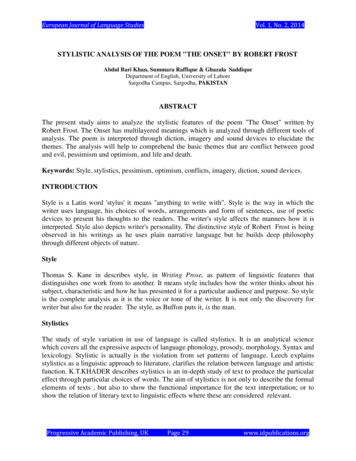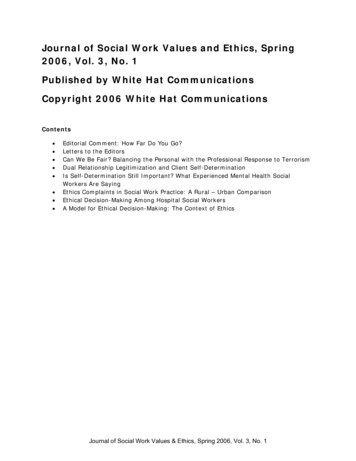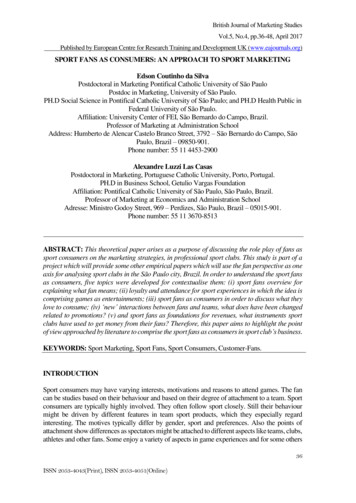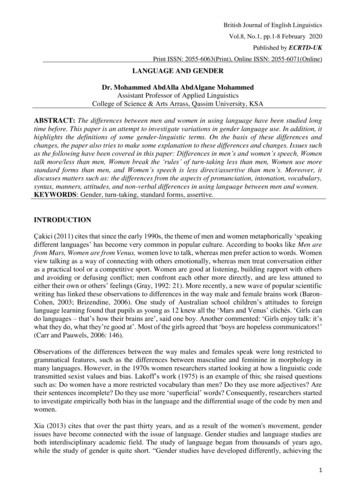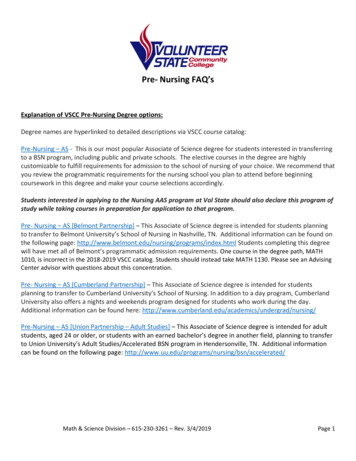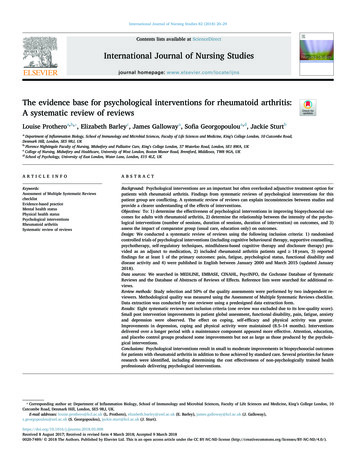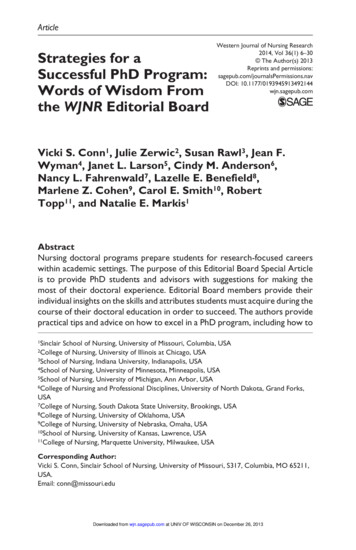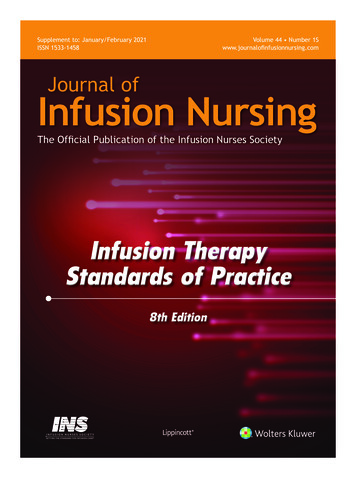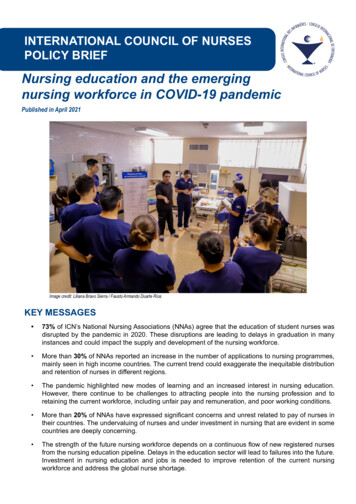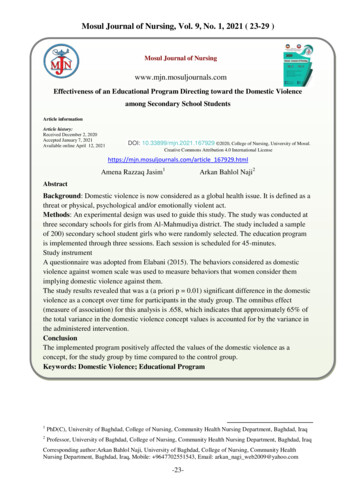
Transcription
Mosul Journal of Nursing, Vol. 9, No. 1, 2021 ( 23-22 )Mosul Journal of Nursingwww.mjn.mosuljournals.comEffectiveness of an Educational Program Directing toward the Domestic Violenceamong Secondary School StudentsArticle informationArticle history:Received December 2, 2020Accepted January 7, 2021Available online April 12, 2021DOI: 10.33899/mjn.2021.167929 2020, College of Nursing, University of Mosul.Creative Commons Attribution 4.0 International Licensehttps://mjn.mosuljournals.com/article 167929.htmlAmena Razzaq Jasim1Arkan Bahlol Naji2AbstractBackground: Domestic violence is now considered as a global health issue. It is defined as athreat or physical, psychological and/or emotionally violent act.Methods: An experimental design was used to guide this study. The study was conducted atthree secondary schools for girls from Al-Mahmudiya district. The study included a sampleof 200) secondary school student girls who were randomly selected. The education programis implemented through three sessions. Each session is scheduled for 45-minutes.Study instrumentA questionnaire was adopted from Elabani (2015). The behaviors considered as domesticviolence against women scale was used to measure behaviors that women consider themimplying domestic violence against them.The study results revealed that was a (a priori p 0.01) significant difference in the domesticviolence as a concept over time for participants in the study group. The omnibus effect(measure of association) for this analysis is .658, which indicates that approximately 65% ofthe total variance in the domestic violence concept values is accounted for by the variance inthe administered intervention.ConclusionThe implemented program positively affected the values of the domestic violence as aconcept, for the study group by time compared to the control group.Keywords: Domestic Violence; Educational Program1PhD(C), University of Baghdad, College of Nursing, Community Health Nursing Department, Baghdad, Iraq2Professor, University of Baghdad, College of Nursing, Community Health Nursing Department, Baghdad, IraqCorresponding author:Arkan Bahlol Naji, University of Baghdad, College of Nursing, Community HealthNursing Department, Baghdad, Iraq, Mobile: 9647702551543, Email: arkan nagi web2009@yahoo.com-23-
Mosul Journal of Nursing, Vol. 9, No. 1, 2021 ( 23-22 )do not experience psychiatric illness(es), thoseof scientific and art tracks, and those who areenrolled in secondary schools within thegeographical boundaries of al-Mahmudiyahdistrict.The exclusion criteria addressed students whoexperience psychiatric illness(es) and thosewho are enrolled in secondary schools outsidethegeographicalboundariesofalMahmudiyah district.The education program that is oriented onfemale students’ perception and attitudestoward domestic violence is implementedthrough three sessions. Each session isscheduled for 45-minutes.Study instrumentA questionnaire was adopted from Elabani(2015). A questionnaire was adopted fromElabani (2015). The questionnaire consisted ofsociodemographic data sheet which includesdemographic characteristics of secondaryschool students such as age, family type,number of family members, and student’s birthorder. The general information includes theresidence area, house ownership, the numberof rooms in the house, the parents’ livingarrangements, the parents’ educationalqualification, and the parents’ occupation.The Definition of domestic violence againstwomen scale was used to measure thestudents’ attitudes toward the concept ofdomestic violence. This scale is a 5-pointLikert type scale that is composed of fiveitems. Responses on this scale ranged from 1(Strongly disagree) to 5 (Strongly agree). Totalscores range from 5 to 25, with a higher scoreindicating negative attitudes toward thedefinition of the concept of domestic violence(Elabani, 2015). The Definition of domesticviolence against women scale showed goodinternal consistency (Cronbach’s alpha 0.772) and both content and face validity(Elabani, 2015).Data were collected by the investigatorthrough the use of a questionnaire and theapplication of the program with the secondaryschools for girls during school visits, the datacollection was initiated from February 20 th toApril 28th, 2019.The study questionnaire was given toparticipants to complete (self-reporting).The estimated time range for each participantto complete the study questionnaire isapproximately 15-minutes that is affirmed bythe pilot study.IntroductionDomestic violence is now considered as aglobal health issue (1). It is defined as a threator physical, psychological and/or emotionallyviolent act; that is, any kind of violenceagainst others with the intention of injuring ordemonstrating power and exercising controlover them (2).According to the WHO (3), domestic violenceagainst female is violence; behavior, within anintimate relationship that causes of physical,sexual or psychological harm, including actsof physical aggression, sexual coercion,psychological abuse and controlling behaviors.Jewkes (4) substantiates that domestic violenceis the inflicting of physical injury, sexual,psychological or economic violence by afamily member or intimate partner,irrespective of whether they lived together ornot. To Okolo (5), violence could beeverywhere in the world today and violenceagainst female is different from context, eventhough there has been great change overtime.In Iraq, at secondary school female studentsexperience a moderate level of abusivebehaviors (6). This study aims to determine theeffectiveness of an educational program inchanging high school female students’attitudes toward domestic violence.Materials and Methods:An experimental design was used to guide thisstudy. The study was conducted at threesecondary schools for girls from AlMahmudiya district. The study included aprobability “stratified” sample of 200)secondary school student girls who wererandomly selected.A (200) high schools for girls. Fourth andfifth-graders students were recruited toparticipate in this study. Based on an effectsize of 0.25, an alpha error probability of 0.05,a power of 0.85, and two groups, the minimumrequired sample size would be 73 for eachgroup. By considering an attrition rate of 20%,an additional 15 participants would be addedto each group. Thus, the final required samplesize would be 88 in each group. The finalsample size is 100 in each group. The firstgroup is called study group, which is exposedto the education program. the second grouphas not exposed to the education program,called control group.The inclusion criteria involved high schoolfemale students who both experienced and donot experienced domestic violence, those who-24-
Mosul Journal of Nursing, Vol. 9, No. 1, 2021 ( 23-22 )theparticipants’sociodemographicData Analyses/StatisticsData were analyzed using the IBM Statisticalcharacteristics. Inferential statistical measuresPackage for Social Science (SPSS) version 26of repeated measures analysis of variancefor Windows .Descriptive statistical(RM-ANOVA), and bivariate Pearsonmeasures of frequency, percentage, mean, andcorrelation.standard deviation were used to demonstrateResults and Discussion:Table 1. Participants’ Sociodemographic CharacteristicsStudy (N 100)Control (N ended1515.01313.0Lower class00.011.3Upper lower class1114.51418.4Lower middle class1722.42532.9Upper middle class4559.23546.1Upper 0955.01033.0 1177.07.331.876.912.22Age (Years)Mean (SD)Family TypeSESNumber of family membersMean (SD)-25-
Mosul Journal of Nursing, Vol. 9, No. 1, 2021 ( 23-22 )The age mean for participants in the studythose who reported that they have been livinggroup is 16.56 1.02; two-fifth age 16-yearsin extended families (n 15; 15.0% vs n 13;(n 40; 40.0%), followed by those who age13.0%) respectively.17-years (n 34; 34.0%), those who age 15-Regarding the number of family members, ayears (n 12; 12.0%), those who age 18-yearsquarter reported that such a number is six (n (n 10; 10.0%), and those who age each of25; 25.0%), followed by each of seven, eight,19-years and 20-years (n 2; 2.0%) for eachand nine (n 19; 19.0%), each of four, five,of them.and 10 (n 5; 5.0%) for each of them, andFor the control group, the age mean is 16.29 each of three, 14, and 15 (n 1; 1.0%) for0.83; a half age 16-years (n 50; 50.0%),each of them.followed by those who age 17-years (n 26;For the control group, the mean is 6.91 2.22;26.0%), those who age 15-years (n 15;the mean for participants in the study group is15.0%), and those who age 18-years (n 9;7.33 1.87; less than a quarter reported that9.0%).such a number is six (n 24; 24.0%),Concerning the family type, the majority bothfollowed by seven (n 22; 22.0%), five (n in the study and control reported that they have17; 17.0%), eight (n 14; 14.0%), four and 11been living in nuclear families (n 85; 85%or more (n 7; 7.0%) for each of them, ninevs n 87; 87.0%) respectively, compared to(n 5; 5.0%).Table 2. Multivariate Tests of the Within-subjects for the domestic violence conceptMultivariate TestsaEffectPillai's TraceDVC(Study)Wilks' Lambda).313dfError dfSig.Partial s Largest Root2.192107.405b2.00098.000.000.687ValueFError llai's Trace(Control.687HypothesisFHotelling's TraceEffectDVCValueWilks' LambdaHotelling's TraceRoy's Largest Root.025.025Hypothesisdf1.2041.2041.204Partial EtaSquaredThere are significant differences in the valuesDVC Domestic violence concepta. Design: Intercept Within Subjects Design:domestic violence conceptb. Exact statisticof the domestic violence concept over time forparticipants both in the study and control-26-
Mosul Journal of Nursing, Vol. 9, No. 1, 2021 ( 23-22 )groups (F 107.405, df 2, p .01 vs. F 1.204, df 2, p .05).Table 3. Tests of Within-Subjects Effects for the domestic violence e IIISum ofSquaresdfMeanSquareFSig.Partial .327Type IIISum .Partial .08663.063There was a (a priori p 0.01) significantviolence concept over time.difference (F (1.177, 116.554) 190.523, p effect (measure of association) for this analysis0.01) in the domestic violence concept overis .016, which indicates that approximatelytime for participants in the study group. The16% of the total variance in the domesticomnibus effect (measure of association) forviolence concept values is accounted for bythis analysis is .658, which indicates thatthe chance.approximately 65% of the total variance in theThe omnibusDiscussiondomestic violence concept values is accountedRegarding students’ attitudes toward thefor by the variance in the administereddomestic violence as a behavior, there was aintervention.statisticallyFor the control group, there was no (a priori psignificantdifferenceinthedomestic violence as a behavior over time for 0.01) significant difference (F (103.387,participants in the study group. The omnibus6243.280) 1.639, p 0.01) in the domesticeffect (measure of association) for this analysis-27-
Mosul Journal of Nursing, Vol. 9, No. 1, 2021 ( 23-22 )is .883, which indicates that approximatelyEthical Clearance: The researchers obtained88% of the total variance in the domesticthe ethical approval from the University ofviolence as a behavior values is accounted forBaghdad, College of ministeredFurthermore,therewereAlhabib S, Nur U, Jones R. Domestic violenceconsistent increase in the values of theagainst women: Systematic review ofdomestic violence as a behavior over time. Theprevalence studies. Journal of Family Violenceresearcher accounts for this finding as that theadministeredintervention[Internet]. 2010 May [cited 2021 Janconsistently8];25(4):369–82.influenced students’ attitudes toward theAli RM, Naji AB, & Jasim AR. Assessment ofdomestic violence as a behavior over time.abusive behaviors among females at secondaryThe study findings almost go in line with thatobtained by Yilmaz(7)schools in Baghdad City: Retrospective study.who concluded that theIOSR Journal of Nursing and Health Sciencemean Attitudes Towards Domestic Violence[Internet]. 2015 [cited 2021 Jan 8]; 4(4):40-47.(ATDV) total score has increased from 55.23Availablefrom:https://searchebscohostcom.ezp 5.84 in the pretest to 57.71 5.07 in theroxy.okcu.edu/login.aspx?direct true&db ccposttest.Crockett, Keneski, Yeager, and Lovingm&AN 131615931&site ehost-live.(8)Crockett E, Keneski E, Yeager K, Loving T.conducted an experimental study to study whoBreaking the mold: Evaluating a non-punitiveconcluded that revealed that there was adomesticsignificant increase in taking accountability forMayConclusion and site ehost-live.behavior, the economic factors contributing tocontributing2021login.aspx?direct true&db ccm&AN 103793violence concept, the domestic violence as cu.edu/constantly affected the values of the domestictheprogram.Available from:The implemented program positively andviolence,interventionJournal of Family Violence [Internet]. 2015violent behaviors from over time.domesticviolenceFlury M, Nyberg E, Riecher-Rössler Definitions, epidemiology, risk factors andrationalization of domestic violence for theconsequences.study group by time compared to the controlSwissmedicalweekly[Internet]. 2010 Sep 2 [cited 2021 Jangroup.8];140:w13099. Available from:Conflict of interest: The researchers /that there is no any conflict of interest.login.aspx?direct true&db mnh&AN 208531Source of Funding: This study is self-funded.95&site ehost-live.-28-
Mosul Journal of Nursing, Vol. 9, No. 1, 2021 ( 23-22 )Jewkes R. Intimate partner violence: Causesand prevention. Lancet [Internet]. 2002 Apr 20[cited 2021 Jan 8];359(9315):1423. kcu.edu/login.aspx?direct true&db pbh&AN 6519731&site ehost-liveOkolo GU. Violence against women. 2004,Baye Communications.World Health Organization [WHO] Violenceagainst women. 2013. Retrieved tions/violence/en/ .Yilmaz EB. The Effectiveness of a GenderEquality Course in Changing UndergraduateMidwifery Students’ Attitudes TowardsDomestic Violence and Gender Roles. CentralEuropean Journal of Nursing & Midwifery[Internet]. 2018 Apr [cited 2021 Jan8];9(2):840.-29-
Mosul Journal of Nursing, Vol. 9, No. 1, 2021 ( 23-22)-23- www.mjn.mosuljournals.com Mosul Journal of Nursing Effectiveness of an Educational Program Directing toward the Domestic Violence among Secondary School Students DOI: 10.33899/mjn.2021.167929 2020, College of Nursing, University of Author: Amena Razzaq Jasim, Arkan Bahlol Naji
